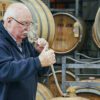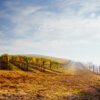
Leading winemaker Brian Croser AO shared his thoughts on smoke taint and the 2020 vintage in an article on the ABC website last week. Several people on social media criticised Brian for some of the things he said in that story. He was even branded a ‘dinosaur’. Here Brian iterates his thoughts on #V20.
BY BRIAN CROSER
What I am about to write is an attempt to reintroduce some civility and logic into the discourse about the quality potential of Australia’s upcoming 2020 vintage, the appropriate response to smoke affected grapes and to the relative roles of climate change and the shorter term periodic climate cycles that affect our wine regions.
I don’t do ‘All a Twitter’ or ‘Instadamn’ and I am grateful Anthony Madigan and WBM are providing me with the opportunity to iterate my thoughts and words spoken and written.
First and foremost, Australia’s wine regions are on track for a moderate size (maybe small) harvest of very high-quality grapes except for the very unfortunate vineyards that have been exposed to proximate and immediate bushfire smoke or have simply run out of water in the drought. The world needs to know that.
Margaret River vignerons are claiming the best potential vintage ever and our own vineyards in the Adelaide Hills, the Fleurieu Peninsula and Wrattonbully are totally unaffected by smoke and enjoying a dry and moderate temperature growing season with small to moderate crops. That description would apply to most of Australia’s grapegrowing regions. It is a slightly delayed vintage and I can hardly wait for it to begin.
Secondly I have not suggested and never would that smoke affected wines be bottled and sold although it is the commercial right of every winemaker to make another decision.
There is an ethical and civil contract of mutual responsibility between winemakers and their growers. I respect that for Geoffrey Weaver in Lenswood whose grapes we take into our winery.
His vineyard was in the middle of the Cudlee Creek inferno but there is much uncertainty around the duration and intensity of smoke and its source (i.e. grass, Eucalypt, burning buildings, even paintings), the susceptibility of pre-veraison grapes and how they will respond to hand picking and very careful extraction. If Geoff is willing to take the chance and spend the money on hand harvesting, we will make the wine and together we will assess its qualities after fermentation. It may seem counterintuitive to invest more in a risky crop but in real financial terms the costs of our winery are already absorbed against the unaffected fruit and the little extra electricity and labour involved is probably less that his picking costs. At least we will know what is affected and be able to rescue what isn’t and just maybe we will learn something along the way.
“You pick it, we will make it.”
Finally the very vexed question of the role of climate change and the shorter term climate cycles in the evolution of the Australian summer and the 2020 vintage.
That climate change is present and growing in magnitude is inarguable.
In 2015 the RD&E sub-committee (of which I was chairman) and the Wine Australia RD&E executive commissioned a study of climate change and the shorter-term climate cycles for the Australian wine regions now and into the future.
The project is described as “Australia’s wine future: Adapting to short-term variability and long-term climate change.”
The participating research institutions were the University of Tasmania through their Antarctic Climate and Ecosystems CRC (climatefutures) and their Department of Geography and Spatial Sciences. Other participants were the CSIRO, SARDI and our very own AWRI. It was of course funded by Wine Australia.
The result is a magnificent and enormous document called Australia’s Wine Future, ‘A Climate Atlas’, that looks at climate, region by region, out to 2100.
I am privileged to have read it before its imminent release and it ilucidates the relative roles of climate change and the shorter climate cycles. They are both important. Seasonal variation has been directly tied to the shorter term cycles.
The Indian Ocean Dipole (IOD), the Southern Annular Mode (SAM), the El Nino-southern oscillation (ENSO), the rare aberration of the Antarctic Vortex we have just experienced and the Madden-Julian Oscillation are prime among other climate cycles that give vignerons an insight into what the season is going to do. The BOM give updates on the state of and predictions about the effects of these cycles on a regular basis as the immediate and direct forces at play in our weather. They don’t give a month by month description of climate change and it would mean little for each individual season anyway. I don’t pretend to be a meteorologist (I would love to have been and it should be taught in tertiary grape and wine courses) but I highly value the insights provided by the BOM. I have only ever used their words about these climate phenomena.
I do hope this short discourse adds to the civil discussion of the big issues confronting our Australian wine community, both short and long term. – Tyrannosaurus Rex
Photograph: Mike Smith Pictures.













Recent Comments